
Return to Gallery
Display Contents
A Gazetteer of Mesolithic sites on Thanet
The sites:
Nethercourt
Bethlehem Farm
Stone Bay Broadstairs
Westwood
Quex Park Birchington
All Saints Avenue
Drapers Mills
QEQM Margate
Northdown Road
Thanet Reach
Chilton
Manston Road Ramsgate
A Late Mesolithic-Early Neolithic Transition of continuity?
Artefact scales in centimetre divisions
Feature scales in ten centimetre divisions
A Gazetteer of
Mesolithic sites on Thanet
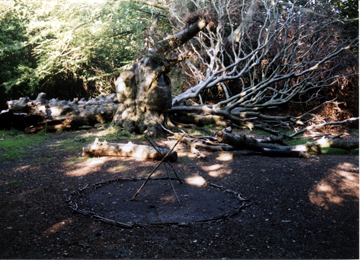
Below is the
current list of sites on
Thanet which are known
to have produced either
certain or
potential evidence of
Mesolithic activity.
All the sites are represented by residual flint scatters, except the Thanet Reach Business Park, Westwood which has produced the only evidence of features possibly dating to this period.
All the sites are represented by residual flint scatters, except the Thanet Reach Business Park, Westwood which has produced the only evidence of features possibly dating to this period.
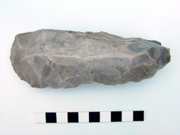
Non-local tranchet adze
The sites are presented in the order of
their
respective entries in the
Thanet Sites and Monuments Register and include bibliographical
references.
At the left-hand side of the page are
'quick-review' summary notes on each entry. Where the site has
also produced evidence of Earlier
Neolithic activity, this has been noted.
Surface find
In 1962 a small Late Mesolithic
flaked axe ('Thames Pick' series) was
discovered in Eskdale Avenue on the Nethercourt Estate. This piece was
unfortunately destroyed in the fire at Ramsgate Library.
NGR 636481 165233
(approximate).
TSMR 163.
Thanet Excavation Group record cards.
Birch et al 1987, p7.
TSMR 163.
Thanet Excavation Group record cards.
Birch et al 1987, p7.
Surface find
A 'Thames Pick' (flint axe) was
found during fieldwalking at Bethlehem
Farm, Cliffsend. It was discovered in a field north of the farm and
south of the railway cutting.
NGR TR 347 646 (area).
NGR TR 347 646 (area).
TSMR 171.
DRJ. Perkins pers comm. with finder.
Birch et al 1987, p7.
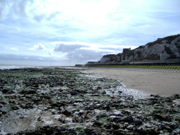
Flint scatter
Geometric microliths
Burins ?
Beach find -
eroded from cliff-top
In 1967 Mr. Montague Puckle
(Deputy Keeper of Archaeology at St. Albans
Museum) found a small flint scraper and 10-12 geometric microliths on
the beach east of Bleak House. He believed them to have eroded from the
clifftop overburden, which at this point is sand and brickearth c.1.5m
deep.
The finds were passed to Dr.
Waecter at the Institute of Archaeology,
London. An attempt to locate these finds has had no succcess so
far.
Another source (Birch et al 1987)
lists the discovery of burins at this location. It is not currently
known whether
these are additional finds or a reference to the Puckle discovery.
NGR 639986 167929
(approximate).
TSMR 213.
Birch et al 1987, p7; Minter and
Herbert 1973, p2.TSMR 213.
Subsoil find
Mesolithic and Neolithic
flints have been found in the subsoil on
both sides of the Margate to Ramsgate road. They have also been
recovered in the gardens of Star Lane and those fronting Ramsgate Road.
The scatter indicates an extensive ocupation site (from TR 364 680 to
364 685).
NGR 636414 168396 (area).
TSMR 270.
Mesolithic flints have been
found at Quex Park and are held by the
Powell-Cotton Museum.
NGR 631243 168339 (area).
TSMR 341.
Nigel Macpherson Grant pers comm.
Wymer 1977.
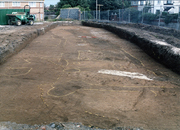
Residual flints
Marsh-side enviroment
Excavation led by Paul Hart, Trust for
Thanet Archaeology; (ASA 04).
This site revealed some residual Mesolithic flintwork. Neolithic flints and features were also present. Some of the flints were potentially of Earlier-Middle Neolithic date, with others from the Late Neolithic-Early Bronze Age. At least one feature (a pit) may potentially date to the Middle Neolithic, with others being later.
The excavation also revealed evidence of the marshy enviroment which formerly existed at this low-lying location. Whether it was present throughout the entire Mesolithic Period is uncertain, though it is likely to have been in place once Post-Glacial sea levels had reached their height.
This site revealed some residual Mesolithic flintwork. Neolithic flints and features were also present. Some of the flints were potentially of Earlier-Middle Neolithic date, with others from the Late Neolithic-Early Bronze Age. At least one feature (a pit) may potentially date to the Middle Neolithic, with others being later.
The excavation also revealed evidence of the marshy enviroment which formerly existed at this low-lying location. Whether it was present throughout the entire Mesolithic Period is uncertain, though it is likely to have been in place once Post-Glacial sea levels had reached their height.
NGR 634832 170423 (approximate).
TSMR 749.
Butler The flint in Hart/Moody (forthcoming); Hart and Moody 2005; Moody 2004.
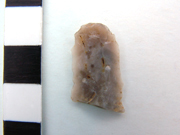
Residual bladelets - LM/EN ?
Excavation led by Paul Hart, Trust for Thanet Archaeology; (DMM 05).
Two proximal bladelet fragments most likely to be of Late Mesolithic or Earlier Neolithic date were recovered here. These pieces were residual in later features.
A site near QEQM Hospital which provided evidence of both Early Neolithic and Late Mesolithic activity is only 600m to the south-west. The evidence from Drapers Mills could be part of the same episode of occupation.
Two proximal bladelet fragments most likely to be of Late Mesolithic or Earlier Neolithic date were recovered here. These pieces were residual in later features.
A site near QEQM Hospital which provided evidence of both Early Neolithic and Late Mesolithic activity is only 600m to the south-west. The evidence from Drapers Mills could be part of the same episode of occupation.
NGR 636180 169920 (approximate).
TSMR 780.
Gardner and Moody 2006.
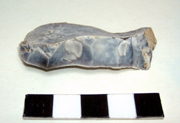
Residual flints in EN pit
Excavation led by Oliver Gardner and Ges
Moody, Trust for Thanet
Archaeology; (NAM05).
Excavations at this site uncovered a small Early Neolithic pit which likely contained residual Late Mesolithic flintwork. This included a rejuvination flake from a bladelet core, possibly Late Mesolithic in date.
Excavations at this site uncovered a small Early Neolithic pit which likely contained residual Late Mesolithic flintwork. This included a rejuvination flake from a bladelet core, possibly Late Mesolithic in date.
NGR 636025 169416 (approximate).
TSMR 807.
Boast/Moody forthcoming.
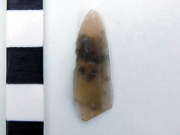
Bladelet fragment - LM/EN ?
Surface find
Watching Brief conducted by Paul Hart,
Trust for Thanet Archaeology; (CRL05).
A 'fieldwalk' of the heavily disturbed surface of this development site recovered a fragment of a small flint blade flake which could well be of Mesolithic or Earlier Neolithic date (though may be later).
A 'fieldwalk' of the heavily disturbed surface of this development site recovered a fragment of a small flint blade flake which could well be of Mesolithic or Earlier Neolithic date (though may be later).
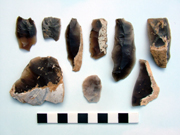
Pit containing flints
4 stake-holes
Evaluation led by David
Perkins, Trust for Thanet Archaeology; (TRP96).
An Evaluation at this site revealed a pit and 4 stake-holes. A small asemblage of worked flints was recovered from the pit. All these features were filled with a fine white loess. Plant colonisation of this soil at Pegwell Bay has been dated to circa 4170BC.
An Evaluation at this site revealed a pit and 4 stake-holes. A small asemblage of worked flints was recovered from the pit. All these features were filled with a fine white loess. Plant colonisation of this soil at Pegwell Bay has been dated to circa 4170BC.
2 microburin-like flakes were
recovered, but no other specifically
diagnostic Mesolithic pieces. This site should date no later than the
very first centuries of the Early Neolithic Period and may well
represent Mesolithic occupation.
The results of further archaeological work conducted latterly at this site by other archaeological units are unknown at present.
The results of further archaeological work conducted latterly at this site by other archaeological units are unknown at present.
NGR 637181 167694 (area).
Perkins 1996; Perkins 1997, p229; Weir, Catt and Madgett 1971.
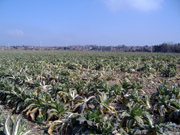
Flint scatter
Butchered animal bone
Surface scatter presumed
Possibly EN ?
Butchered animal bones and flint
blade-flakes were discovered here at what may have been an open camp
site
(D.R.J.
Perkins pers comm.); (finds
with
the owner).
NGR 636257 164702 (area).
Birch et al 1987, p7.
This location is close to an Earlier Neolithic Causewayed Enclosure which could well be the source of the finds. There are difficulties in distinguishing general Early Neolithic flintwork from Late Mesolithic material lacking specific diagnostic pieces. However, Thanet's only examples of Mesolithic axes have also been found nearby - at Nethercourt (I) and Bethlehem Farm (II).
Residual bladelets - LM/EN ?
Excavation led by Jack Russell, Trust
for Thanet Archaeology (MRR04).
A site next to the Tesco store revealed a residual bladelet and bladelet fragment which could be of Late Mesolithic or Earlier Neolithic date (though may be later). Evidence of both periods has been recovered nearby (sites I and XI).
A site next to the Tesco store revealed a residual bladelet and bladelet fragment which could be of Late Mesolithic or Earlier Neolithic date (though may be later). Evidence of both periods has been recovered nearby (sites I and XI).
Of the two options it is possible that
they may date to the Earlier Neolithic on account of them being made
of Bullhead Bed flint (though this is highly speculative). Evidence
from the Early Neolithic pit at QEQM (site VIII) shows the certain use
of Bullhead flint confined to the contemporary, Early Neolithic
material.
NGR 636009 165644 (approximate).
Boast 2006.
Transition of continuity?
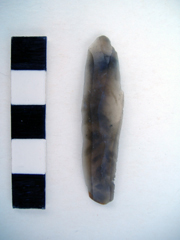
Early Neolithic bladelet from QEQM
However this may be a reflection that many aspects of their daily lives remained the same and people living a hunter-gatherer lifestyle at the very end of the Mesolithic would have been unaware that they were crossing our somewhat artificial boundary into the New Stone Age circa 4200BC.
Several sites on Thanet have produced evidence of both Mesolithic/Late Mesolithic and Earlier Neolithic occupation. They cannot be said with certainty to illustrate a continuity of occupation of favoured locations; precise dating evidence is too poor for that. However we may be getting a hint that our Early Neolithic ancestors were following in the footsteps of their Late Mesolithic forebears.
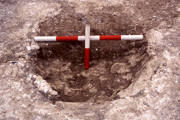
Pit at QEQM
The Chilton site (XI) could be another good example, should certain Mesolithic flints have been recovered here. Both of Thanet's Mesolithic axes have been found close to this spot; a location which became home to a Causewayed Enclosure in the Earlier Neolithic.
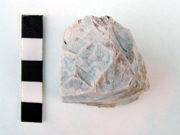
Early Neolithic flint core from
North Foreland Avenue
A Beaker barrow discovered at North Foreland Avenue produced Early Neolithic flintwork from the backfill of the grave. Two small cube-shaped cores were recovered, plus a bladelet (which would not have been out of place in a Late Mesolithic flint assemblage). Mesolithic tools had previously been found just over 1km to the south at Stone Bay (III).
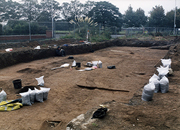
All Saints Avenue Margate
A site at All Saints Avenue Margate
(VI) revealed residual Mesolithic activity plus flints of
potential Early to Middle Neolithic date. There were also some
Neolithic features,
though the earliest would most likely be only of Middle Neolithic date.
This site also provided evidence of the mere which gave its name to
'Mere-Gate'; showing
that our Mesolithic ancestors may have been utilising the marshy
enviroment here.
TSMR - Thanet Sites and Monuments Record.
Birch D., Boakes P., Elworthy S., Hollins C. and Perkins D.R.J. 1987. The Gateway Island - Archaeological Discoveries in Thanet 1630-1987. Thanet Archaeological Unit.
Boast E.J. 2006. Excavations at Manston Road Ramsgate. Trust for Thanet Archaeology report (in preparation).
Hart P.C. 2005 . A three-storey building for Churchill Retirement Living, 326 Northdown road, Cliftonvile, Kent. Trust for Thanet Archaeology report.
Hart P.C. and Moody G.A. 2005. All Saints Avenue, Margate, Kent. Trust for Thanet Archaeology Assessment report.
Gardner O.W. and Moody G. 2006. Excavations at Drapers Mills County Primary School, Margate, Kent. Trust for Thanet Archaeology report.
Minter K.S. and Herbert E.F. 1973. Archaeological discoveries in Broadstairs and St. Peter's up to 1972. Broadstairs and St. Peter's Archaeological Society.
Moody G.A. 2004. 135 All Saints Avenue, Margate, Kent. Trust for Thanet Archaeology Evaluation report.
Oxford Archaeology 2005. Land adjacent to Tesco Extra, Margate Road, Broadstairs, Kent.
Perkins D.R.J. 1996. Thanet Reach Business Park. Trust for Thanet Archaeology report.
Perkins D.R.J. 1997. Thanet Reach Business Park site, St. Peter's, Broadstairs. Archaeologia Cantiana CXVII.
Weir A.H., Catt J.A. and Madgett P.A. 1971. Periglacial soil formation in the loess at Pegwell Bay, Kent. Geoderma 5.
Wymer J.J. 1977. A Gazetteer of Mesolithic and Upper Palaeolithic Sites in England and Wales. CBA Research Report no. 20.
Version 1 - Posted 02.04.06
Version 2 - Posted 17.05.06
Version 3 - Posted 25.07.06
Version 4 - Posted 21.10.06
All
content © Trust for Thanet Archaeology